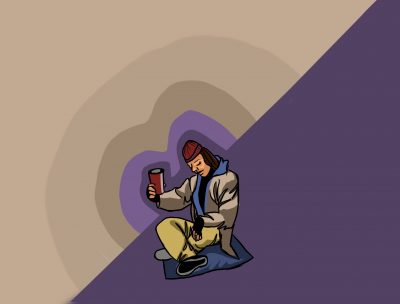Throughout Boston, residents are greeted with the sight of benches divided by armrests that may look unassuming, but in reality prevent people from laying down on them. These restrictive seat dividers are a type of hostile architecture: a design approach that purposefully makes an environment uncomfortable to prevent individuals experiencing homelessness from frequenting these areas.
Hostile architecture is one of many ways the government and institutions work to push unhoused communities out of sight.
The pandemic has only exacerbated this kind of inaccessibility, especially on our campus. Access to areas that had previously been places of refuge for vulnerable populations has been heavily curtailed due to social distancing measures.
The George Sherman Union and the Mugar Library were previously open to non-students and used to be essential sources of food, warmth, bathroom facilities and water for the unhoused population. Now, no one can enter the GSU if they are not students and do not have a green badge.
Moreover, on-campus stores and dining facilities such as City Convenience do not accept cash, and in some cases, can only be accessed through GrubHub. These kinds of cashless payment restrictions have been shown to negatively affect low-income households, especially the individuals experiencing homelessness who may not have access to any other kind of funds.
The pandemic has provided a place for institutions to further pre-existing wealth inequality under the guise of protecting public safety — whether intentional or not.
This is not to say that Boston University is not justified in enacting these restrictions. But the pandemic has exposed how these types of public health measures — both at BU and the world at large — do not consider its most vulnerable community members.
Whether it be through off-campus housing or simply walking around campus, students regularly interact with Boston residents. Students may even pose a significant risk to Boston residents with COVID-19 transmission: House parties held by college students in particular were a huge area of concern of community transmission for South Boston residents. Boston became a high-risk community after reports of these parties.
Opening access to BU community testing sites for Boston residents who need it would be a significant step in ensuring public safety for all.

BU holds significant power over the landscape of Boston. For years now, the University has significantly contributed to the gentrification of the city, particularly in Kenmore Square. BU’s presence in the area has only grown since the pandemic: Due to the devastating effects of COVID-19 on restaurants, BU-affiliated properties are rapidly becoming the backbone of Kenmore.
Extending resources to the very communities BU helped push out of their neighborhoods is the very least it could do.
There are over 6,000 unhoused people in the city of Boston. From 2019 to 2020, there was a 6.8% increase in the number of families without a home, according to the 40th Annual Homeless Census. The pandemic has only worsened the housing crisis, making a population without resources to get treatment or get tested all the more vulnerable.
Taking care of those people does not work against public health measures, but rather should be an essential and central part of these plans and safety measures.
This is not to say that BU is solely responsible for addressing Boston’s housing crisis, but as a prominent community member, BU has a responsibility to do better.
This can be enacted in small ways. For instance, people do not necessarily need to show their ID to get on the BU Shuttle, making this a resource available to everyone who regularly traffics our campus. BU could better distribute our resources by making other services — such as our testing resources, dining services and buildings — safely accessible to residents.
Last year BU opened part of its campus up to house staff from homeless shelters. BU could expand these efforts and offer housing to individuals without shelter during the summertime.
But it is not enough to simply remove hostile elements of our campus. It is also important to be actively anti-hostile towards our most vulnerable communities. BU should create spaces and resources that explicitly address the systemic roots of homelessness.
“The Individual in Community” HUB requirement requires students to learn to “accept individual responsibility” and “work as engaged members” of their communities.
Does our campus, as a major community member of Boston, reflect this shared responsibility?
BU should work on striking a balance between making campus regulations that are COVID-19 safe while also holding space for the most vulnerable members of our community.





















































































































Amy Seedhom • Apr 23, 2021 at 1:14 pm
Great editorial! Very informative.